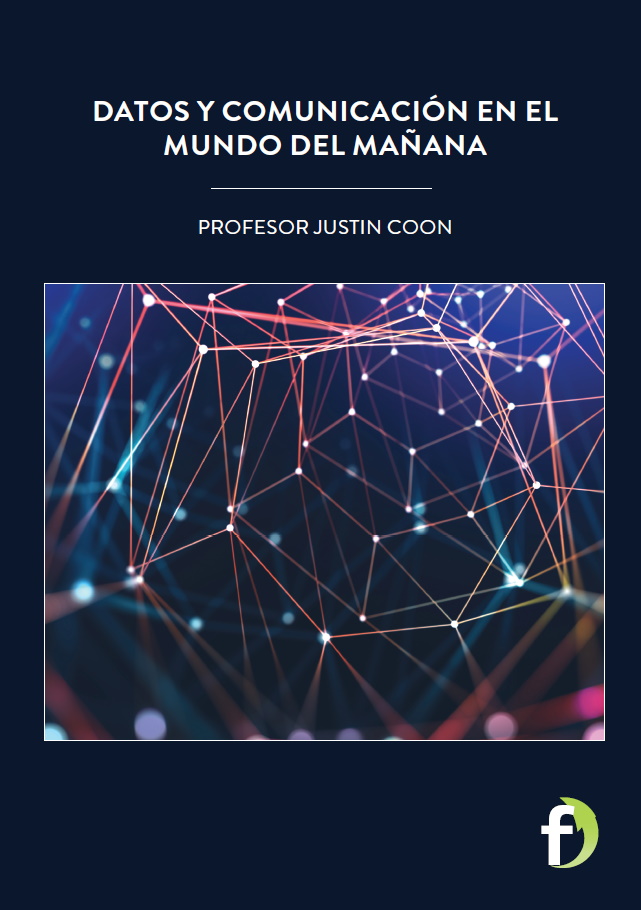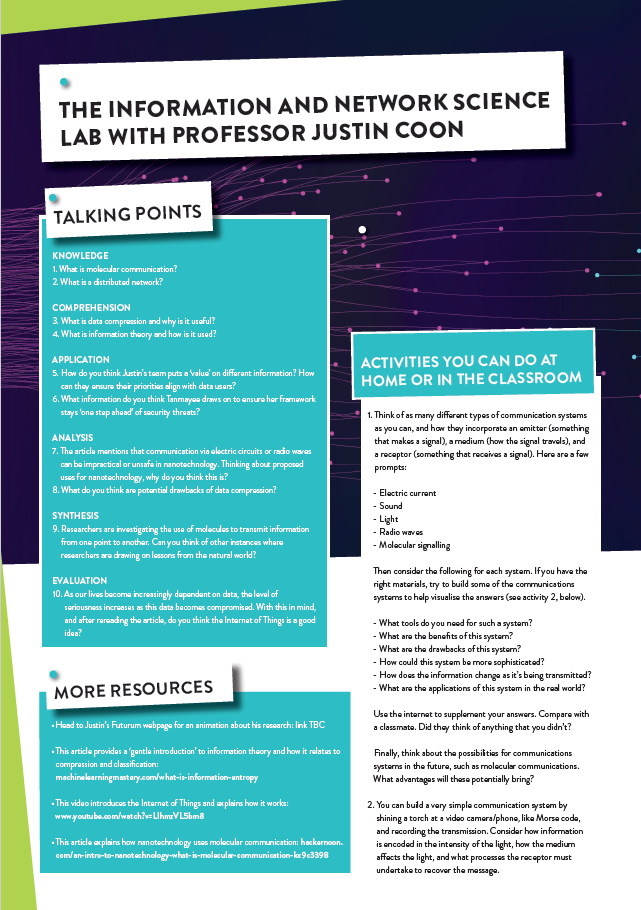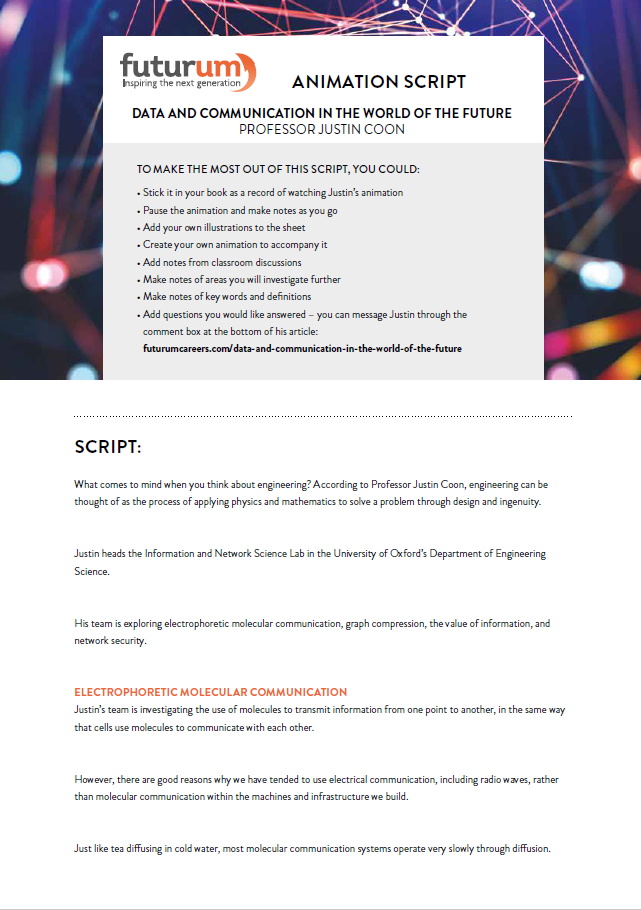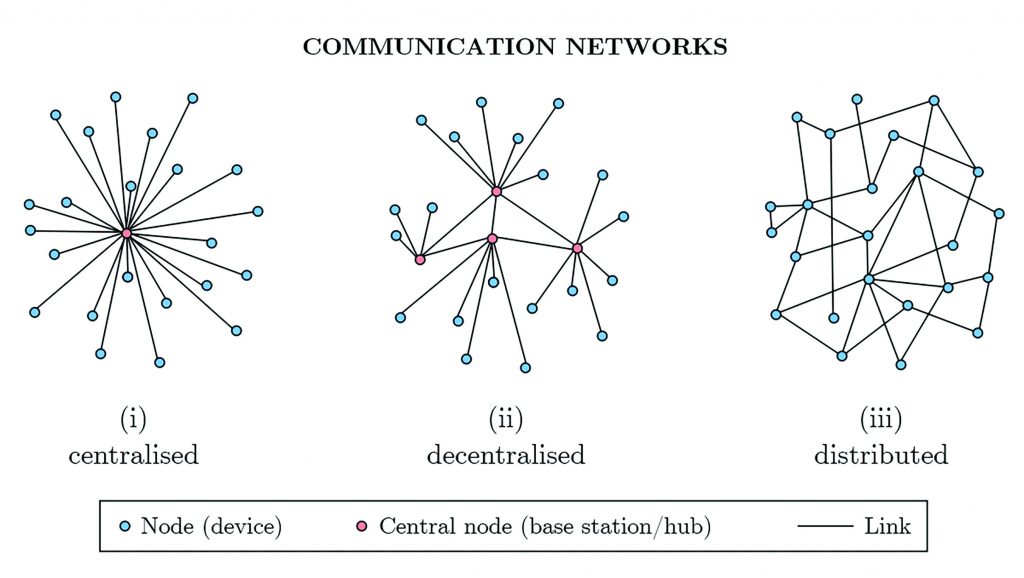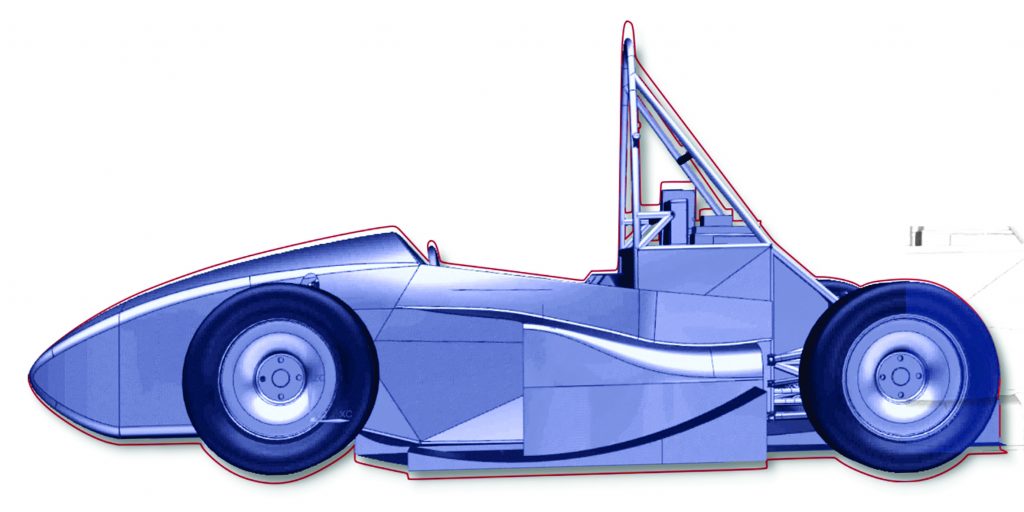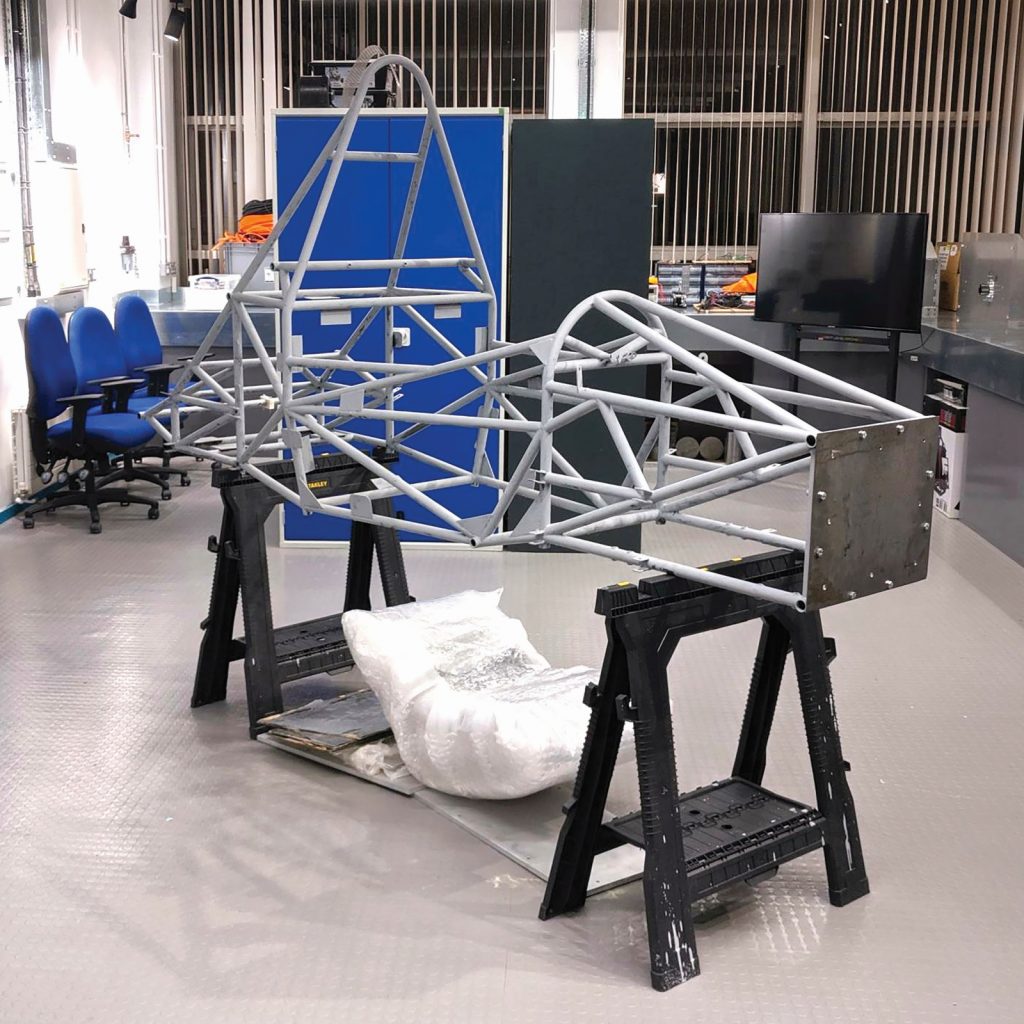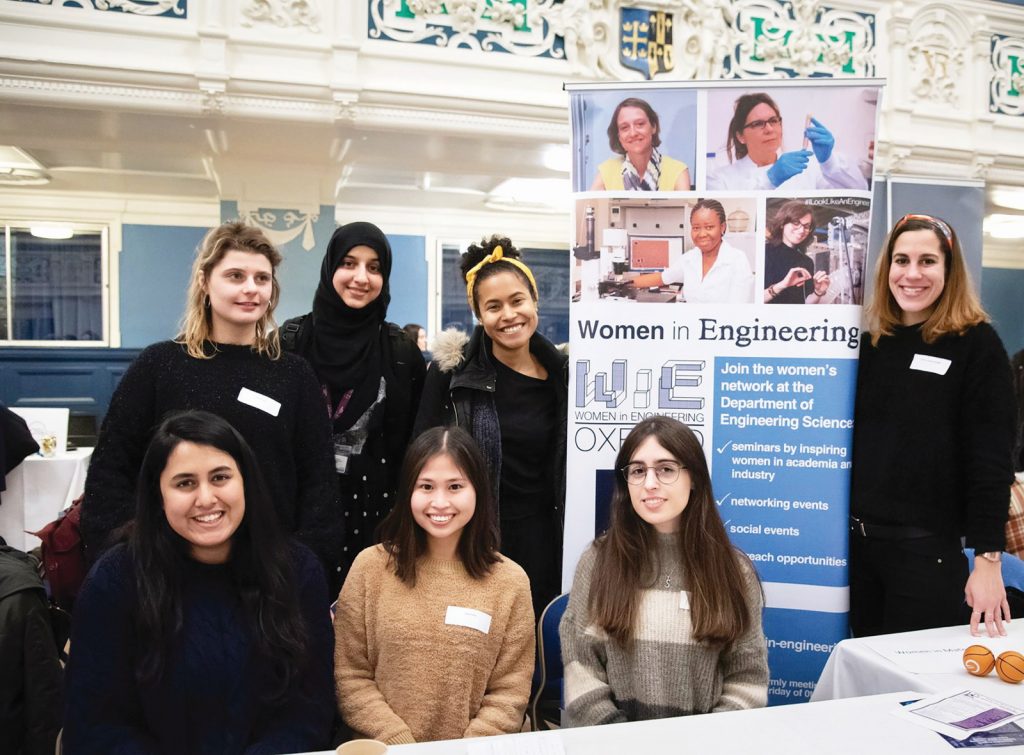Data and communication in the world of the future
As our lives become increasingly intertwined with technology, we need increasingly sophisticated ways of managing data and communicating. Professor Justin Coon and his team at the University of Oxford in the UK are working on a variety of research projects, involving molecular communication, data compression and prioritisation, and safeguarding the incoming ‘internet of things’
GLOSSARY
DATA COMPRESSION – modifying data (e.g., through encoding or restructuring) to reduce their size
DISTRIBUTED NETWORKS – when the computer in a communication network communicates directly to other computers or devices in the network instead of passing messages through an intermediary
ELECTROPHORETIC – the migration of molecules through a fluid subjected to an electric field
FLUID DYNAMICS – the study of the mathematics and physics behind the flow of liquids and gases
INFORMATION THEORY – the mathematical study of the coding of information, and how rapidly this information can be transmitted
INTERNET OF THINGS – the internet-connected network of computing devices embedded in everyday objects
MOLECULAR COMMUNICATION – using the presence, absence, or concentration of molecules to digitally encode a message
“Engineering can be thought of as the process of applying physics and mathematics to solve a problem through design and ingenuity,” says Professor Justin Coon, who heads the Information and Network Science Lab at the University of Oxford’s Department of Engineering Science. “At Oxford, we teach engineering in a holistic manner to capture the foundational principles of physics and mathematics.”
The researchers in Justin’s lab come from a variety of mathematics, physics, and engineering backgrounds. “Some have studied communication and information theory to an advanced level, while others have expertise in material physics and fluids,” he says. They are pooling their specialties to work on innovative projects, looking at novel ways of approaching communication and data. “We do what we do because we are curious, we want to learn, and we want to contribute to the body of knowledge that humans have been building for millennia,” says Justin. “Every day that we discover something new – a new theory, a novel way of approaching a problem, a clever design for a system – feels like an achievement.”
Justin’s lab is exploring electrophoretic molecular communication, graph compression, the value of information and network security. The team’s wide-ranging work shows that studies in engineering and communications can be incredibly broad and fascinating.
ELECTROPHORETIC MOLECULAR COMMUNICATION
Nanotechnology is becoming increasingly advanced, to the point where there is scope for a ‘nanonetwork’. This is where nanomachines communicate with each other. However, while we tend to use electric circuits or radio waves to fulfil this function, these methods can be impractical or unsafe at the nano level. Finding alternatives is a prime topic of research, and drawing on lessons from the natural world, where cells often use molecules to communicate, may provide a solution.
There is a growing and diverse research community investigating molecular communication – using molecules to transmit information from one point to another. “For example, biologists have made progress towards identifying properties of bacteria to propel information,” says Justin. “Engineers, on the other hand, have focused on how to encode information in chemical and biological systems, through variations in molecule concentrations.”
However, there are good reasons why we have tended to use electrical communication rather than molecular communication within the machines and infrastructure we build. “Most molecular communication systems operate very slowly through diffusion – think about tea diffusing in cold water,” says Justin. “Even when we speed the process up (such as by stirring the tea), the system remains limited by the laws of fluid dynamics.” Making such a system responsive to rapid changes in inputs is a key challenge.
Justin’s lab is working to solve this problem. “In our lab, we are working on a specific kind of molecular communication that utilises electric fields to propel information-carrying molecules to different parts of the system.” Electric fields react very quickly, so by using them to induce molecular motion, it should be possible to build rapid and responsive communication systems. Justin compares these systems to a simple electrical circuit, comprising a battery, a conductive wire and a lightbulb. “In our case, the battery creates a strong electric field, and instead of a wire, we have a liquid confined in a tube,” he says. “Instead of electrons, we have molecules that carry information to the lightbulb.”
“We don’t know exactly what impact this research will have, but we do have some ideas,” says Justin. “There has been a lot of work on nano devices in recent years, which our research could potentially improve.” These devices have implications for all sorts of fields, such as drug development and environmental monitoring. “Most of these devices are currently limited by fluid physics,” says Justin. “We hope our research will help improve their performance, making them more usable for real world applications.”
GRAPH COMPRESSION
There is a huge amount of data in the modern world – so much, in fact, it can be difficult to know what to do with it. “Whether we like it or not, our lives are underpinned and driven by data these days,” says Justin. “Most data, and most physical systems, are connected in some way, just like points on a graph are connected by links between them.”
Storing, processing, and communicating this data relies upon being able to represent it efficiently – which is where compression comes in. “Compression involves encoding datasets so that fewer resources – bits, in this case – are used,” says Justin.
To understand how compression works, think about the first line of this carol: Jingle bells, jingle bells, jingle all the way. If we want to ‘compress’ this into fewer letters, we can represent it as A B, A B, A C D E – where A = jingle, B = bells, and so on. As long as whoever is sent the compressed version knows the code, all the data are still there.
However, this is an extremely straightforward example. “The complexity of the problem is exciting,” says Justin. “For instance, if you draw 25 dots on a piece of paper to represent the points in a graph, and then attempt to connect them using every possible combination of links, the number of graphs you could construct is larger than the number of atoms in the known universe.” It is possible to use mathematical rules to reduce this complexity to something manageable for basic smartphones or laptops. Justin’s team is working on developing a tool for the visual representation of graph compression algorithms. They aim to make such tools more user-friendly for the real world.
Reference
https://doi.org/10.33424/FUTURUM244
DATA COMPRESSION – modifying data (e.g., through encoding or restructuring) to reduce their size
DISTRIBUTED NETWORKS – when the computer in a communication network communicates directly to other computers or devices in the network instead of passing messages through an intermediary
ELECTROPHORETIC – the migration of molecules through a fluid subjected to an electric field
FLUID DYNAMICS – the study of the mathematics and physics behind the flow of liquids and gases
INFORMATION THEORY – the mathematical study of the coding of information, and how rapidly this information can be transmitted
INTERNET OF THINGS – the internet-connected network of computing devices embedded in everyday objects
MOLECULAR COMMUNICATION – using the presence, absence, or concentration of molecules to digitally encode a message
“Engineering can be thought of as the process of applying physics and mathematics to solve a problem through design and ingenuity,” says Professor Justin Coon, who heads the Information and Network Science Lab at the University of Oxford’s Department of Engineering Science. “At Oxford, we teach engineering in a holistic manner to capture the foundational principles of physics and mathematics.”
The researchers in Justin’s lab come from a variety of mathematics, physics, and engineering backgrounds. “Some have studied communication and information theory to an advanced level, while others have expertise in material physics and fluids,” he says. They are pooling their specialties to work on innovative projects, looking at novel ways of approaching communication and data. “We do what we do because we are curious, we want to learn, and we want to contribute to the body of knowledge that humans have been building for millennia,” says Justin. “Every day that we discover something new – a new theory, a novel way of approaching a problem, a clever design for a system – feels like an achievement.”
Justin’s lab is exploring electrophoretic molecular communication, graph compression, the value of information and network security. The team’s wide-ranging work shows that studies in engineering and communications can be incredibly broad and fascinating.
ELECTROPHORETIC MOLECULAR COMMUNICATION
Nanotechnology is becoming increasingly advanced, to the point where there is scope for a ‘nanonetwork’. This is where nanomachines communicate with each other. However, while we tend to use electric circuits or radio waves to fulfil this function, these methods can be impractical or unsafe at the nano level. Finding alternatives is a prime topic of research, and drawing on lessons from the natural world, where cells often use molecules to communicate, may provide a solution.
There is a growing and diverse research community investigating molecular communication – using molecules to transmit information from one point to another. “For example, biologists have made progress towards identifying properties of bacteria to propel information,” says Justin. “Engineers, on the other hand, have focused on how to encode information in chemical and biological systems, through variations in molecule concentrations.”
However, there are good reasons why we have tended to use electrical communication rather than molecular communication within the machines and infrastructure we build. “Most molecular communication systems operate very slowly through diffusion – think about tea diffusing in cold water,” says Justin. “Even when we speed the process up (such as by stirring the tea), the system remains limited by the laws of fluid dynamics.” Making such a system responsive to rapid changes in inputs is a key challenge.
Justin’s lab is working to solve this problem. “In our lab, we are working on a specific kind of molecular communication that utilises electric fields to propel information-carrying molecules to different parts of the system.” Electric fields react very quickly, so by using them to induce molecular motion, it should be possible to build rapid and responsive communication systems. Justin compares these systems to a simple electrical circuit, comprising a battery, a conductive wire and a lightbulb. “In our case, the battery creates a strong electric field, and instead of a wire, we have a liquid confined in a tube,” he says. “Instead of electrons, we have molecules that carry information to the lightbulb.”
“We don’t know exactly what impact this research will have, but we do have some ideas,” says Justin. “There has been a lot of work on nano devices in recent years, which our research could potentially improve.” These devices have implications for all sorts of fields, such as drug development and environmental monitoring. “Most of these devices are currently limited by fluid physics,” says Justin. “We hope our research will help improve their performance, making them more usable for real world applications.”
GRAPH COMPRESSION
There is a huge amount of data in the modern world – so much, in fact, it can be difficult to know what to do with it. “Whether we like it or not, our lives are underpinned and driven by data these days,” says Justin. “Most data, and most physical systems, are connected in some way, just like points on a graph are connected by links between them.”
Storing, processing, and communicating this data relies upon being able to represent it efficiently – which is where compression comes in. “Compression involves encoding datasets so that fewer resources – bits, in this case – are used,” says Justin.
To understand how compression works, think about the first line of this carol: Jingle bells, jingle bells, jingle all the way. If we want to ‘compress’ this into fewer letters, we can represent it as A B, A B, A C D E – where A = jingle, B = bells, and so on. As long as whoever is sent the compressed version knows the code, all the data are still there.
However, this is an extremely straightforward example. “The complexity of the problem is exciting,” says Justin. “For instance, if you draw 25 dots on a piece of paper to represent the points in a graph, and then attempt to connect them using every possible combination of links, the number of graphs you could construct is larger than the number of atoms in the known universe.” It is possible to use mathematical rules to reduce this complexity to something manageable for basic smartphones or laptops. Justin’s team is working on developing a tool for the visual representation of graph compression algorithms. They aim to make such tools more user-friendly for the real world.
VALUE OF INFORMATION
With so much data in the modern world, there needs to be a prioritisation system in place. “We are working on formalising the value of information in networks of sensor devices,” says Justin. “This work is based on the field of information theory, which was pioneered by Claude Shannon in the 1940s and forms the basis of all digital communication systems today.”
Justin’s team uses Shannon’s theory alongside properties of probability and statistics to attach a value to data. “Shannon defined a notion of information that is based on how likely an event is to occur,” says Justin. For instance, tossing a coin is equally likely to result in heads or tails – this binary 50/50 result forms one ‘bit’ of information. However, if the coin is weighted towards heads, then an observer who knows this could predict that a heads result is more likely, even without doing the experiment. This means there is less than one bit of information present – the result will ‘probably be heads’. A little information is lost here (the possibility of getting tails) but in this model that is deemed less important than the data saved.
Justin illustrates how this valuation plays out in the real world. “Sensors are deployed to measure pollution levels, temperature, traffic and so on,” he says. “The information generated at these sensors is communicated to computers where the data is processed, but not all the information is high-value.” Justin’s team is working on developing ways to quantify which data should be communicated, and when it should take place to avoid outdated data. “This will help computers process and react to information as efficiently as possible, thus improving our quality of life and perhaps even saving lives,” he says.
NETWORK SECURITY
Tanmayee Deshprabhu is a PhD student in Justin’s lab, whose research investigates how to provide security for future communication networks. “Many future networks will be distributed, which means that, rather than messages and data going through a central hub, devices will instead speak directly with one another,” she says. Distributed networks form the foundation of the ‘Internet of Things’, which involves devices in many aspects of our lives communicating with each other – washing machines and fridges connecting to our smartphones, traffic lights connecting to CCTV cameras, medical databases connecting to AI diagnosis software, energy sources communicating with the power grid, and so on.
However, the lack of a central hub that can oversee these interactions means that this interconnectedness could be exploited maliciously, putting people at risk. “Recently, I worked on identifying the vulnerable points of direct and unregulated communications in a distributed network,” says Tanmayee. “Understanding the security risks means that our future systems can be designed to avoid them.” She is utilising machine learning to build classification tools, which use information about past attacks to identify patterns that can predict and pre-empt future attacks. This should allow the individual components of the Internet of Things to independently carry out their own risk assessments.
One major issue is that attacks are always evolving, becoming more advanced as the technology designed to resist them becomes more sophisticated. “The goal of my research is to work towards a distributed security framework that can stay one step ahead of these attacks,” says Tanmayee. “This is a vital stepping stone to making our everyday lives more connected and instant. For example, we could use these networks to coordinate emergency response vehicles, or dynamically combine renewable energy resources for a stable power network.”
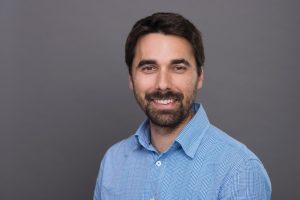 PROFESSOR JUSTIN COON
PROFESSOR JUSTIN COON
Head, Information and Network Science Lab, Department of Engineering Science, University of Oxford, UK
FIELD OF RESEARCH: Engineering Science
RESEARCH PROJECT: The Information and Network Science (INS) Lab conducts research on a wide variety of information and communication theories and technologies at many different scales and for a broad array of applications.
https://eng.ox.ac.uk/information-and-network-science-lab/
FUNDERS: Engineering and Physical Sciences Research Council (EPSRC), grant number EP/T02612X/1 (ProTo-Net); John Fell Fund (grant no. 0006235)
WHAT DID YOU WANT TO BE WHEN YOU WERE YOUNGER?
Many things! My aspirations ranged from becoming a rock ‘n’ roll guitarist to a surgeon.
WHAT INSPIRED YOU TO STUDY ELECTRICAL ENGINEERING?
When I was around 17, I realised that I found mathematics to be beautiful, interesting, and fun to learn. I wanted to study something at university that would lead to a mathematics-heavy career, and electrical engineering presented an opportunity to apply physics and mathematics in an unfamiliar context. I figured that if I was going to spend four years studying a course, I’d like to learn something new!
HOW WAS YOUR TIME WORKING OUTSIDE OF ACADEMIA?
I worked for Toshiba Research Europe Ltd for just under nine years. I started as a research engineer, developing new communication techniques for use in Wi-Fi and cellular networks. I published and patented my work, and one of my inventions was even adopted into 4G networks. As I became more experienced, I led a group of researchers doing similar things. I really enjoyed working with people and experiencing different cultures during my period with Toshiba.
WHAT IS IT LIKE TO LEAD YOUR OWN LAB?
Keeping on top of the latest developments in the field is tough, especially since I also spend time teaching undergraduate students. However, there are many benefits, since learning new things and speaking to interested students about the topics I am passionate about is always enjoyable.
WHAT DO YOU DO TO RELAX?
I still play guitar – mostly classical these days – and also enjoy gardening, joinery, playing squash, walking in in the countryside, and spending time with my family.
 PROFESSOR JUSTIN COON
PROFESSOR JUSTIN COON
Head, Information and Network Science Lab, Department of Engineering Science, University of Oxford, UK
FIELD OF RESEARCH: Engineering Science
RESEARCH PROJECT: The Information and Network Science (INS) Lab conducts research on a wide variety of information and communication theories and technologies at many different scales and for a broad array of applications.
https://eng.ox.ac.uk/information-and-network-science-lab/
FUNDERS: Engineering and Physical Sciences Research Council (EPSRC), grant number EP/T02612X/1 (ProTo-Net); John Fell Fund (grant no. 0006235)
WHAT DID YOU WANT TO BE WHEN YOU WERE YOUNGER?
Many things! My aspirations ranged from becoming a rock ‘n’ roll guitarist to a surgeon.
WHAT INSPIRED YOU TO STUDY ELECTRICAL ENGINEERING?
When I was around 17, I realised that I found mathematics to be beautiful, interesting, and fun to learn. I wanted to study something at university that would lead to a mathematics-heavy career, and electrical engineering presented an opportunity to apply physics and mathematics in an unfamiliar context. I figured that if I was going to spend four years studying a course, I’d like to learn something new!
HOW WAS YOUR TIME WORKING OUTSIDE OF ACADEMIA?
I worked for Toshiba Research Europe Ltd for just under nine years. I started as a research engineer, developing new communication techniques for use in Wi-Fi and cellular networks. I published and patented my work, and one of my inventions was even adopted into 4G networks. As I became more experienced, I led a group of researchers doing similar things. I really enjoyed working with people and experiencing different cultures during my period with Toshiba.
WHAT IS IT LIKE TO LEAD YOUR OWN LAB?
Keeping on top of the latest developments in the field is tough, especially since I also spend time teaching undergraduate students. However, there are many benefits, since learning new things and speaking to interested students about the topics I am passionate about is always enjoyable.
WHAT DO YOU DO TO RELAX?
I still play guitar – mostly classical these days – and also enjoy gardening, joinery, playing squash, walking in in the countryside, and spending time with my family.
JUSTIN’S TOP TIPS
01 Seek ways to learn about the subject at a high level. For example, local chapters of the Institute of Electrical and Electronics Engineers (www.ieee.org), the Institution of Engineering and Technology (www.theiet.org), and the Institute of Mathematics and its Applications (ima.org.uk) often organise public lectures, publish literature, and run courses.
02 Speak to people that work in the field. And, of course, study mathematics and physics!
MEET TANMAYEE

TANMAYEE DESHPRABHU
PHD STUDENT, INFORMATION AND NETWORK SCIENCE LAB, UNIVERSITY OF OXFORD
WHAT INSPIRED YOU TO WORK WITH DISTRIBUTED NETWORKS?
When I was younger, the idea of the fully automated homes in Dexter’s Laboratory or Wallace & Gromit fascinated me. With the advent of 6G for Internet of Things applications, these fantasy ideas might be closer to reality than we think!
HOW DID YOU COME TO WORK AT THE INFORMATION AND NETWORK SCIENCE LAB?
My undergraduate degree was in electrical and electronic engineering, followed by a master’s in communication engineering. After my final exams, I saw a listing on a graduate opportunities page about the lab, and once I read about their work, I found it aligned really well with my interests. I never saw myself applying for a PhD unless it was in a field I am passionate about.
WHERE DO YOU SEE YOU CAREER HEADING?
I have learned many new skills during my PhD that I hope will be applicable for a range of careers, so I’m still exploring my options. The field of communication engineering is hugely diverse in its opportunities, and I would be especially thrilled to work with something related to space research.
HAS WORKING IN A MALE-DOMINATED FIELD EVER POSED AN ISSUE FOR YOU?
Being the gender minority in a group is something that you get used to over time. The wider community of women in STEM is welcoming and supportive, so it’s important to seek out those groups and societies that highlight this community, such as Oxford’s Women in Engineering Network. The only time it has felt like an issue is when awards or titles have been unnecessarily hinged on my gender – ‘Best girl in engineering’, for example. Fortunately, this sort of culture seems to have improved over the past few years, and it’s encouraging to see that the ratio of female students in engineering tends to increase with every new cohort. I hope that trend continues.
WHAT OTHER ENGINEERING-RELATED ACTIVITIES DO YOU TAKE PART IN?
I am a member of Oxford University Racing’s marketing and sponsorship team. Car racing is really cool, especially from an engineering perspective. We are working on building an electric race car for an international competition, and there’s a huge sense of teamwork and collaboration – within the team and with other teams across the world. Being on the marketing team helps me to connect my engineering background with my graphic design hobby by producing creative content that engages the public. As part of this, I recently set up a collaboration with a local charity called Universify Education, which supports students from non-selective states schools in applying for top universities.
• Ask questions and reach out to people for guidance, even when it feels like you should already know the answer.
• Don’t be afraid to apply for opportunities, even if they seem out of reach.
• Get involved in societies and student organisations, both related
Do you have a question for Justin or Tanmayee?
Write it in the comments box below and Justin or Tanmayee will get back to you. (Remember, researchers are very busy people, so you may have to wait a few days.)


